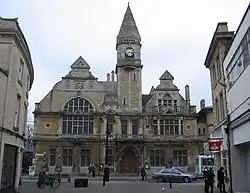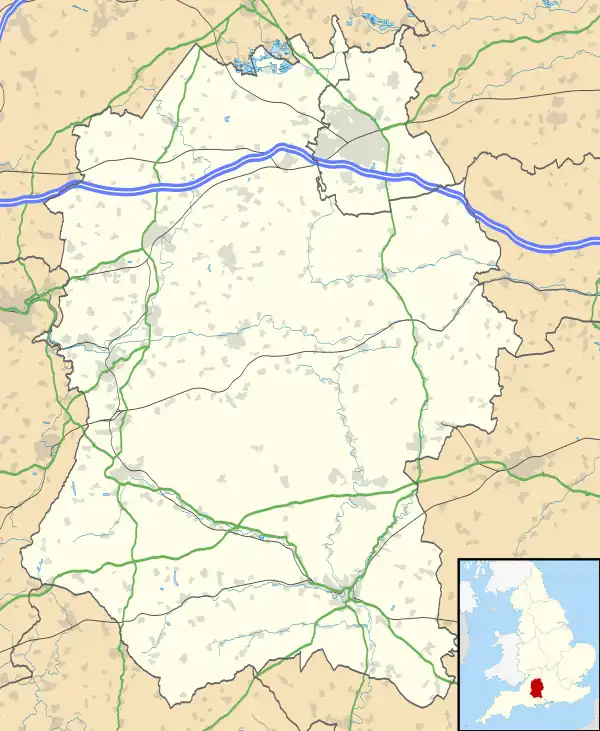Trowbridge Town Hall
Trowbridge Town Hall is a municipal building in Market Street, Trowbridge, Wiltshire, England. The town hall, which was the headquarters of Trowbridge Urban District Council, is a Grade II listed building.[1]
| Trowbridge Town Hall | |
|---|---|
 Trowbridge Town Hall | |
| Location | Market Street, Trowbridge |
| Coordinates | 51.3201°N 2.2068°W |
| Built | 1889 |
| Architectural style(s) | Jacobethan style |
Listed Building – Grade II | |
| Official name | Town Hall |
| Designated | 26 November 1976 |
| Reference no. | 1364209 |
 Shown in Wiltshire | |
History

After significant population growth, largely associated with the cloth industry, a local board of health was established in Trowbridge in 1864.[2] In the 1880s, the local board decided that the town needed a municipal building, and a wealthy cloth merchant, Sir William Roger Brown, offered to pay for it to celebrate the Golden Jubilee of Queen Victoria.[2] The site the board acquired was then occupied by a large private house known as "The Limes".[2]
The foundation stone for the new building was laid by Mrs Brown on 21 June 1887,[3] when she declared:
"In the name of God the Father, God the Son and God the Holy Ghost, I declare this stone well and truly laid, that on it a Town Hall may be erected for the benefit of the inhabitants of Trowbridge, as a memorial of the blessings vouchsafed to us, the people of England, during the fifty years of Her Majesty’s reign, completed on this day. God Save the Queen!"[4]
The new building was designed in the Jacobethan style. It was built in ashlar stone at a cost of £20,000 and was opened by the Duchess of Albany on 14 June 1889.[3] The design involved an asymmetrical main frontage with three bays facing onto Market Street; the central bay featured an arched doorway flanked by brackets supporting a balustrade; there was a pair of mullion windows on the first floor and a tall Italianate style clock tower with a spire above.[1] (The clock, of 1888, was provided by J. W. Benson Ltd.)[5] In the left hand bay there was a giant round headed window with tracery on the first floor and a shaped gable above, while to the right there was a large oriel window with a shaped gable above.[1] Internally, the principal rooms were the courtroom, which was used as a venue for petty sessions,[2] the council chamber and the ballroom.[6] The building was also equipped with police cells for people facing trial and an area to the rear of the town hall was landscaped to create a "Sensory Garden".[7]
On 6 August 1889, soon after the creation of Wiltshire County Council, one of its earliest meetings took place at Trowbridge Town Hall.[8]
In 1894, the parish of Trowbridge became an urban district, with the town hall as its headquarters,[9] and in November 1917 King George V and Queen Mary visited the town hall on a visit to the area.[7][10] The ballroom was used for local dances and musical events, and in the 1960s performers appearing there included the rock bands Rod Stewart and the Soul Agents, in December 1964,[11] The Who, in April 1965,[12] and Small Faces in August 1965.[12]
The building continued to serve as the headquarters of the urban district council for much of the 20th century,[13] but ceased to be the local seat of government after the enlarged West Wiltshire District Council was formed in new offices at Bradley Road in 1974.[14][15][16] After 1974, the town hall belonged to West Wiltshire District Council, and then from 2009 to its successor Wiltshire Council, which considered disposing of it.[16] It continued to be used as a magistrates' court until 2003[17] and was also used as the venue for coroners' inquests into the deaths of military personnel.[18][19]
In 2011, a group of residents formed the Trowbridge Town Hall Trust to help restore the building,[20] and since then it has been used for exhibitions and community events.[7]
Works of art in the town hall include a bust by Edward Sheppard depicting the benefactor, Sir William Roger Brown,[21] as well as portrait of him by an unknown artist.[22]
References
- Historic England. "Town Hall (1364209)". National Heritage List for England. Retrieved 1 April 2021.
- Chettle, H. F.; Powell, W. R.; Spalding, P. A.; Tillott, P. M. (1953). "'Parishes: Trowbridge', in A History of the County of Wiltshire: Volume 7, ed. R B Pugh and Elizabeth Crittall". London: British History Online. pp. 125–171. Retrieved 1 April 2021.
- Plaque on the left of the doorway to the town hall
- "Proposal for Council Asset Transfer – Trowbridge Town Hall", page 2, wiltshire.gov.uk, accessed 7 August 2022
- Pickford, Chris, ed. (1995). Turret Clocks: Lists of Clocks from Makers' Catalogues and Publicity Materials (2nd ed.). Wadhurst, E. Sussex: Antiquarian Horological Society. p. 210.
- "Our history". Trowbridge Town Hall. Retrieved 1 April 2021.
- "A guided tour inside Trowbridge Town Hall with Director David Lockwood". Trowbridge Nub News. 23 July 2020. Retrieved 1 April 2021.
- "Wiltshire County Council" in Devizes and Wiltshire Gazette, Thursday 8 August 1889, p. 1
- "Trowbridge UD". Vision of Britain. Retrieved 1 April 2021.
- "Royal visit: 9 November 1917" (PDF). Melksham Remembers. Retrieved 1 April 2021.
- "The Soul Agents". Bruno Ceriotti. Retrieved 1 April 2021.
- "Trowbridge Gig History". BBC. Retrieved 1 April 2021.
- "No. 44711". The London Gazette. 7 November 1968. p. 11980.
- Local Government Act 1972. 1972 c.70. The Stationery Office Ltd. 1997. ISBN 0-10-547072-4.
- "No. 46805". The London Gazette. 23 January 1976. p. 1212.
- "More than 90 council buildings will be sold to save £85m". Wiltshire Times. 15 October 2009. Retrieved 1 April 2021.
- "Magistrates' courts to close". BBC. 10 June 2003. Retrieved 1 April 2021.
- "Trowbridge hall's valuable artefacts are 'under threat'". Wiltshire Times. 16 July 2011. Retrieved 1 April 2021.
- "Ten years of war, 10 years of inquests". BBC. 4 October 2011. Retrieved 1 April 2021.
- "Trowbridge Town Hall tours provide insight into iconic building". Wiltshire Times. 5 June 2015. Retrieved 1 April 2021.
- Sheppard, Edward. "William Roger Brown (1831–1902)". Art UK. Retrieved 1 April 2021.
- "Sir Roger Brown". Art UK. Retrieved 1 April 2021.